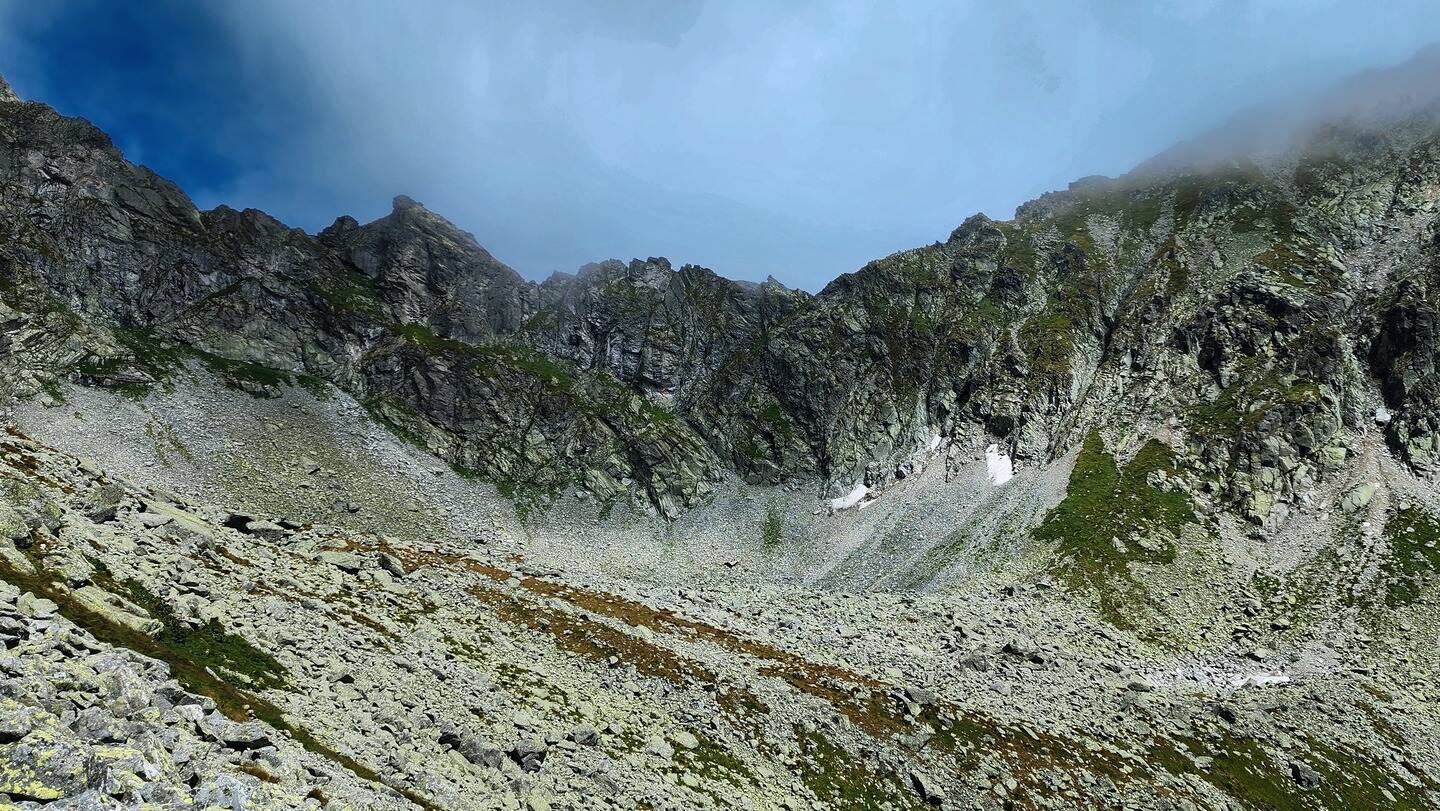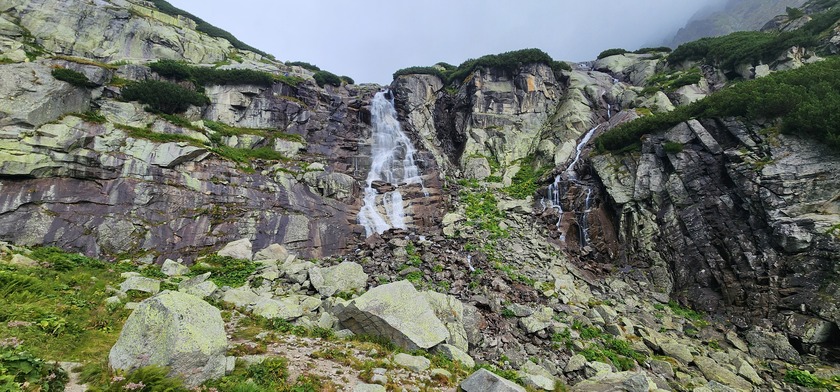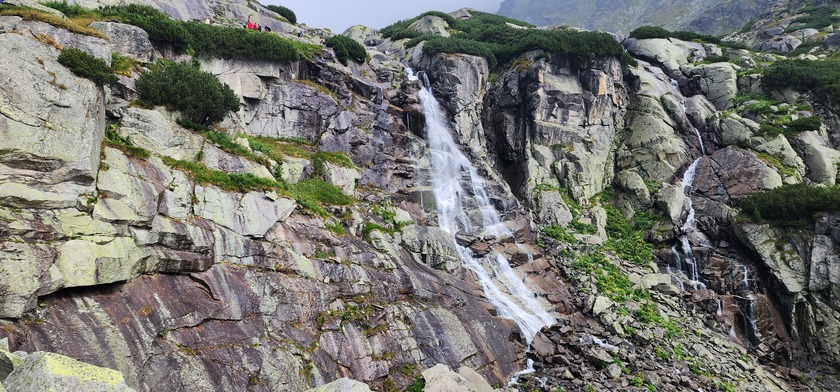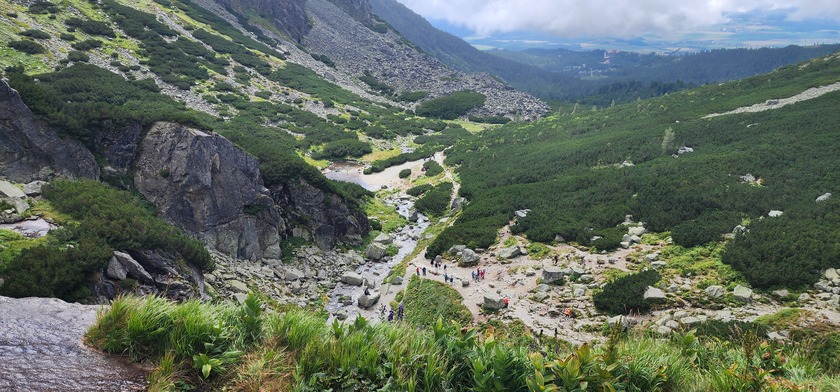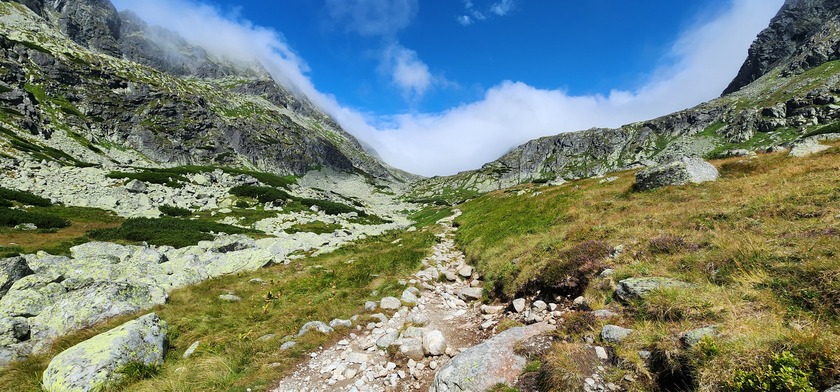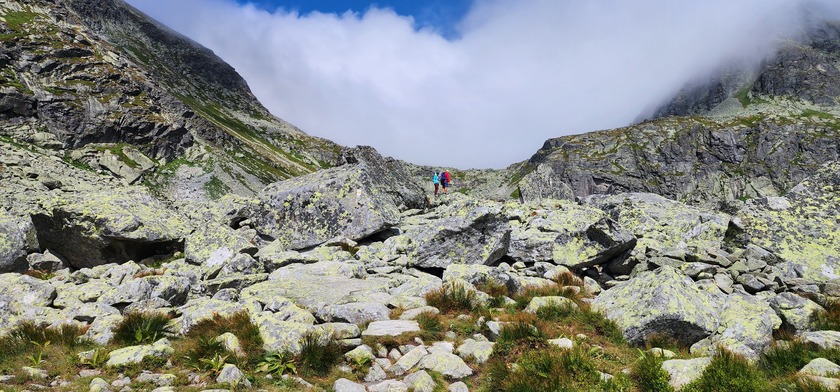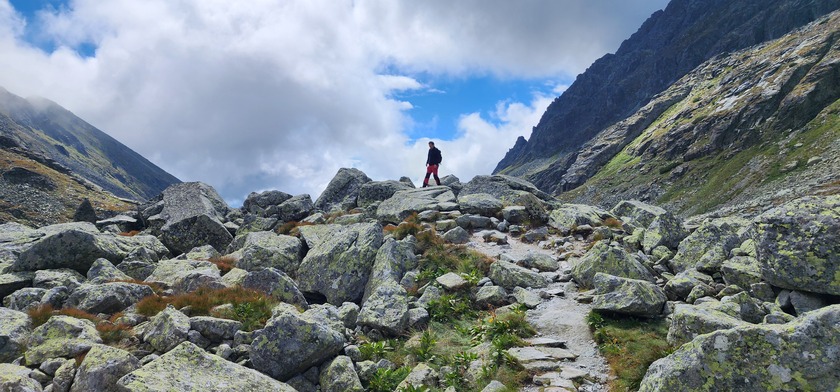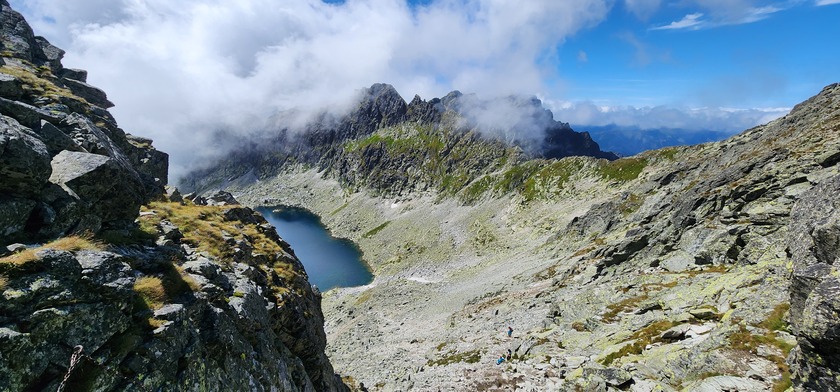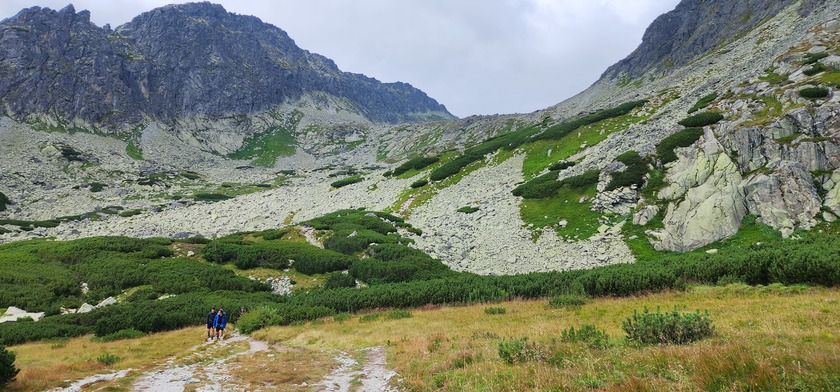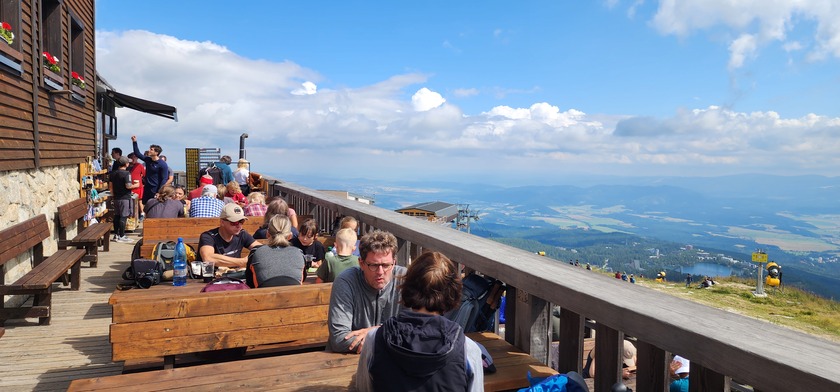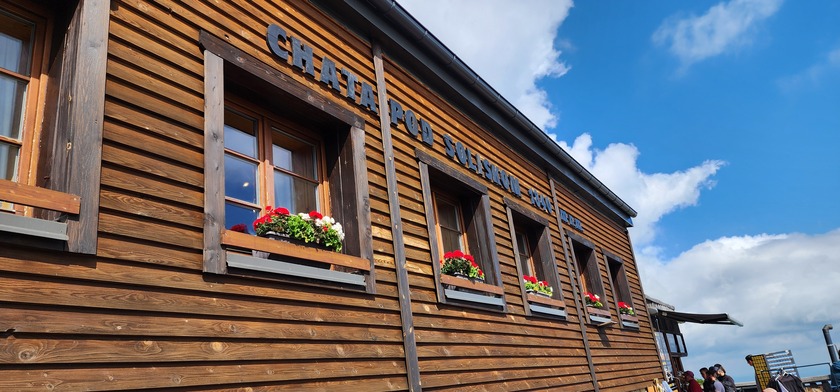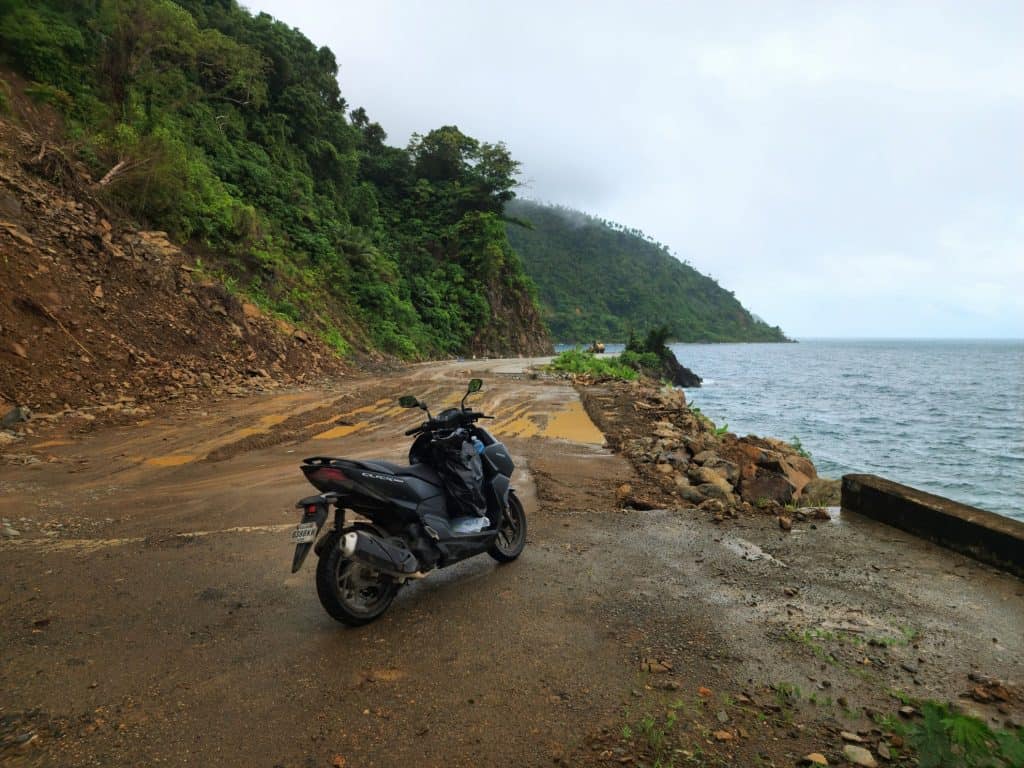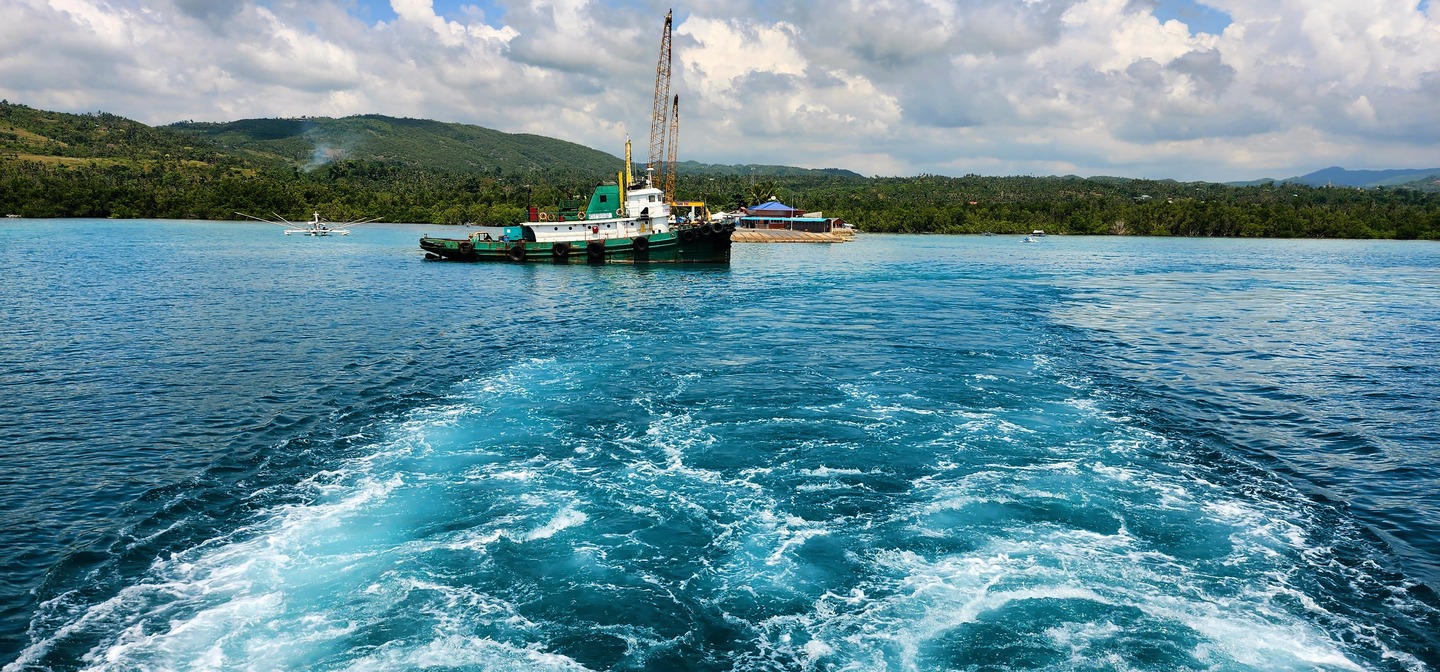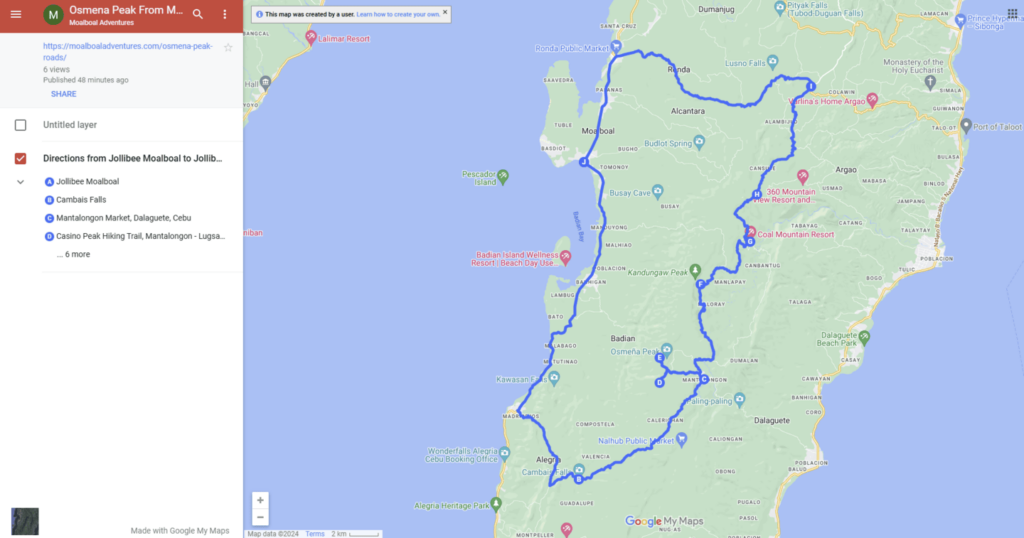Bystra Lavka is one of the most spectacular and challenging hikes in the High Tatras, Slovakia. This full-day adventure takes you through the scenic valleys of Furkotská dolina and Mlynická dolina, featuring stunning alpine lakes, breathtaking mountain views, and the impressive Skok Waterfall. The hike culminates with a crossing of the high mountain pass at Bystra Lavka, providing breathtaking views. From here, you have several options: you can descend via the blue trail to Solisko Cabin, where you can hike or take the cable car back down to Štrbské Pleso. Alternatively, you can continue down the yellow trail, which connects to the red trail, leading you back to Štrbské Pleso.
- Location: High Tatras, Slovakia.
- Difficulty: Moderate to Difficult.
- Season: Hiking Season opens around June 15th and closes around October 15th. (can vary slightly each year)
- Best Time: Late June to September for clear trails and stable weather.
- Length: Approximately 14-16 kilometers, depending on the exact route taken.
- Duration: Around 6-9 hours for the full circuit.
- Elevation Gain: About 1,100 meters.
- Highest Point: Bystra Lavka Pass at 2,315 meters above sea level.
- Scenery: Stunning mountain peaks, lush valleys, and multiple glacial lakes.
- Highlights: The narrow Bystrá Lávka pass, Skok Waterfall, a cascading water spectacle, and panoramic views.
What to Expect
Difficulty: The Bystra Lavka trail is renowned for its challenging nature. The final ascent, which involves climbing with the aid of chains, is particularly strenuous. Hikers should be in good physical shape and possess solid hiking experience to tackle this trail effectively. The final ascent includes sections with chains, demanding strength, endurance, and confidence on rocky terrain.
Crowds: Expect initial crowds, especially at the trailhead and near the first lake. However, the number of hikers usually diminishes significantly beyond this point, allowing for a more solitary experience as you progress. For a quieter hike, weekdays are your best bet, as weekends tend to be very crowded.
Weather: The High Tatras are renowned for their unpredictable weather, often described as a microclimate. Conditions can shift dramatically, with sunshine rapidly giving way to rain, snow, or even violent storms. This volatile environment makes hiking and mountaineering in the region both exhilarating and demanding.
Trail Conditions: The terrain is predominantly rocky and requires careful navigation. Some sections can be quite demanding, necessitating a good sense of balance. Snow conditions may vary throughout the year, impacting the trail’s difficulty and accessibility.
Essential Gear: Proper hiking gear is crucial for this trail. Ensure you have sturdy hiking boots, warm clothing (especially for the summit), and sufficient water.
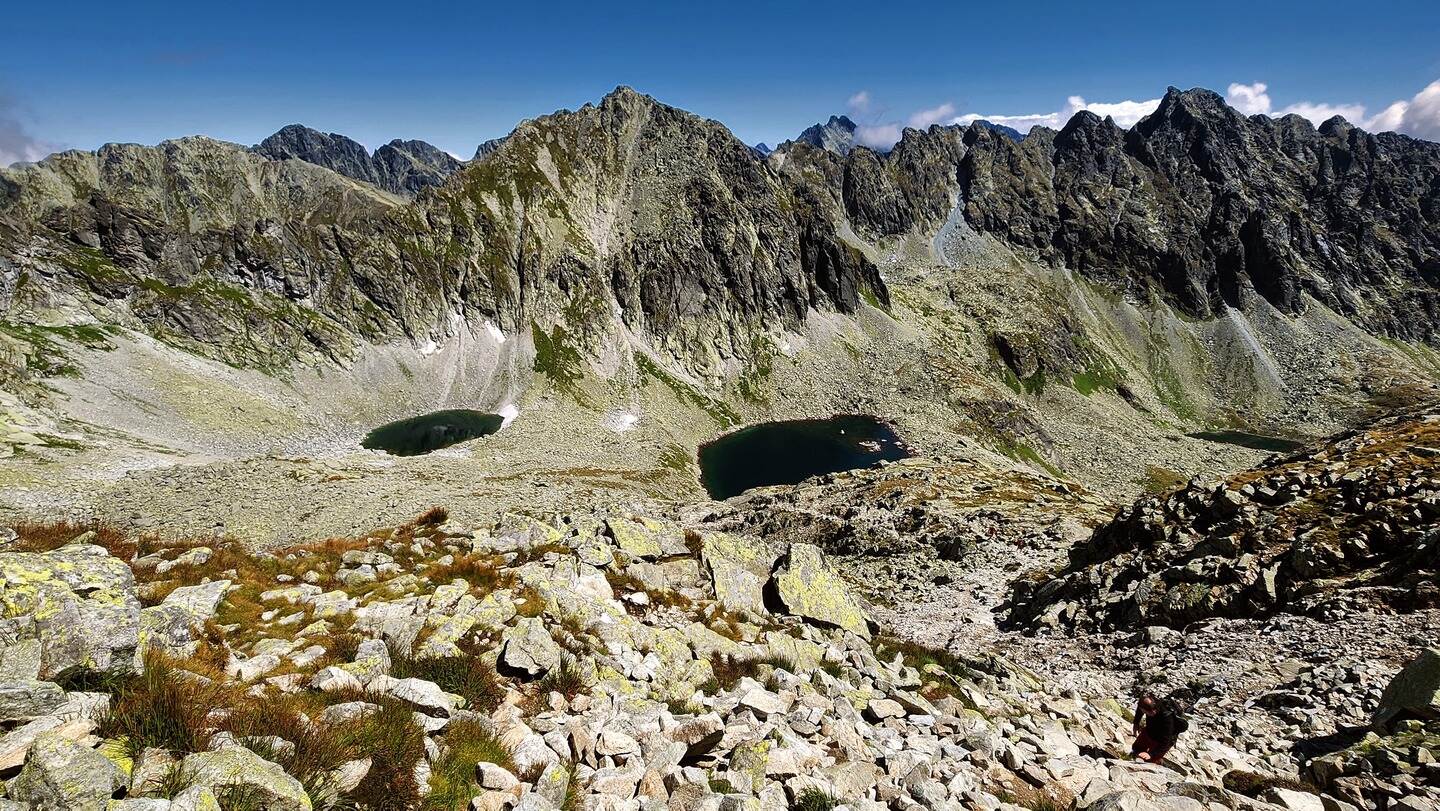
As you make your way toward Bystrá Lávka in Mlynická Dolina, you’ll pass between two stunning glacial lakes. Okruhle Pleso, a smaller and tranquil lake, lies on your left, while the larger Capie Pleso, with its crystal-clear waters, is on your right. This scenic stretch, with lakes on either side, is a highlight of the hike as you approach the challenging ascent to Bystrá Lávka.
Overall Experience:
The Bystra Lavka trail is a gratifying hike for those who are well-prepared and seeking a demanding adventure. It’s ideal for experienced hikers looking for a rewarding challenge amidst breathtaking scenery. Ensure you’re equipped to handle diverse weather conditions and have all the necessary gear for a safe and enjoyable hike.
Initial Ascent: The hike begins at the Štrbské Pleso train station, situated at 1,355 meters above sea level. From here, you’ll follow a tarmac road leading to the ski jumps, where you pick up the yellow waymarked hiking trail. This trail guides you through a tranquil ascent into the peaceful Mlynická dolina. The path starts off gently, winding through a forested area with majestic spruce trees. Though the trail is generally well-maintained, expect some uneven ground with roots and rocks. Sturdy hiking boots with good ankle support are essential to navigate this terrain.
Skok Waterfall: As you gain altitude and approach the Skok Waterfall, the terrain becomes more challenging. The stony path leading up becomes narrower and steeper, with hairpin bends assisting in the climb. Along the way, you’ll notice the large rock formation known as Kazatelnica, or “pulpit,” as you ascend into the dwarf pine zone. Soon, you’ll arrive at the base of the Skok Waterfall, which boasts a spectacular 25-meter drop from a ledge at 1,789 meters above sea level. The final approach to the waterfall involves ascending a steep, rocky section with the aid of chains in some places. This part of the hike demands surefootedness and upper body strength but rewards you with one of the region’s most beautiful natural sights.
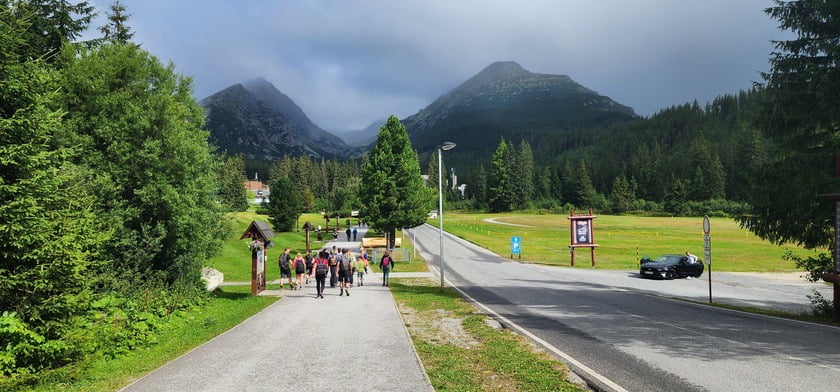
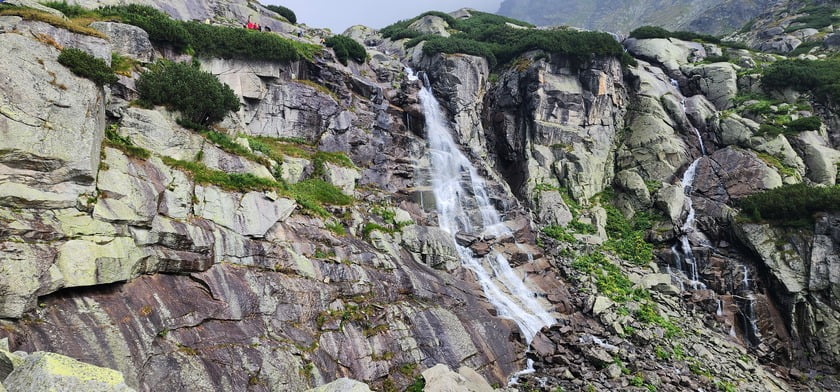
Left Image: The hike starts at the Štrbské Pleso train station, located at an elevation of 1,355 meters. From there, you’ll follow a paved road to the ski jumps, where you can access the yellow-marked hiking trail. Right Image: Skok Waterfall features an impressive 25-meter drop from a ledge at 1,789 meters above sea level.
Mlynická Dolina: Beyond Skok, the trail continues through the Mlynická Dolina, a glacial valley where the terrain becomes even more rugged. This section is characterized by large boulders and scree, making it particularly demanding on the feet. Careful foot placement and a good sense of balance are crucial here, as the path is less defined and more challenging.
The plane wreckage near Skok Waterfall is from a tragic incident that occurred in 1974 when a Soviet military aircraft crashed in the High Tatras. The wreckage has become an intriguing landmark for hikers, providing a stark contrast to the stunning natural scenery.
Visitors often stop to explore the remnants, which include various metal fragments and parts of the fuselage, surrounded by the rugged beauty of the mountains. The site serves as a memorial to those lost in the crash and adds a layer of history to the hiking experience in the area.
The final ascent to Bystrá Lávka, the highest point of the hike, is the most challenging and exhilarating part of the journey. Standing at an elevation of 2,300 meters, this narrow mountain pass requires not only physical stamina but also a steady mind. The trail becomes increasingly steep and rocky, with sections that are particularly exposed. As you approach the pass, you’ll encounter chains installed to aid hikers in navigating the most difficult and narrow passages. These chains are essential for safety, as the path can be treacherous, especially with loose scree underfoot. The climb to Bystrá Lávka tests your limits, but the reward is a panoramic view of the High Tatras that makes every step worth it.
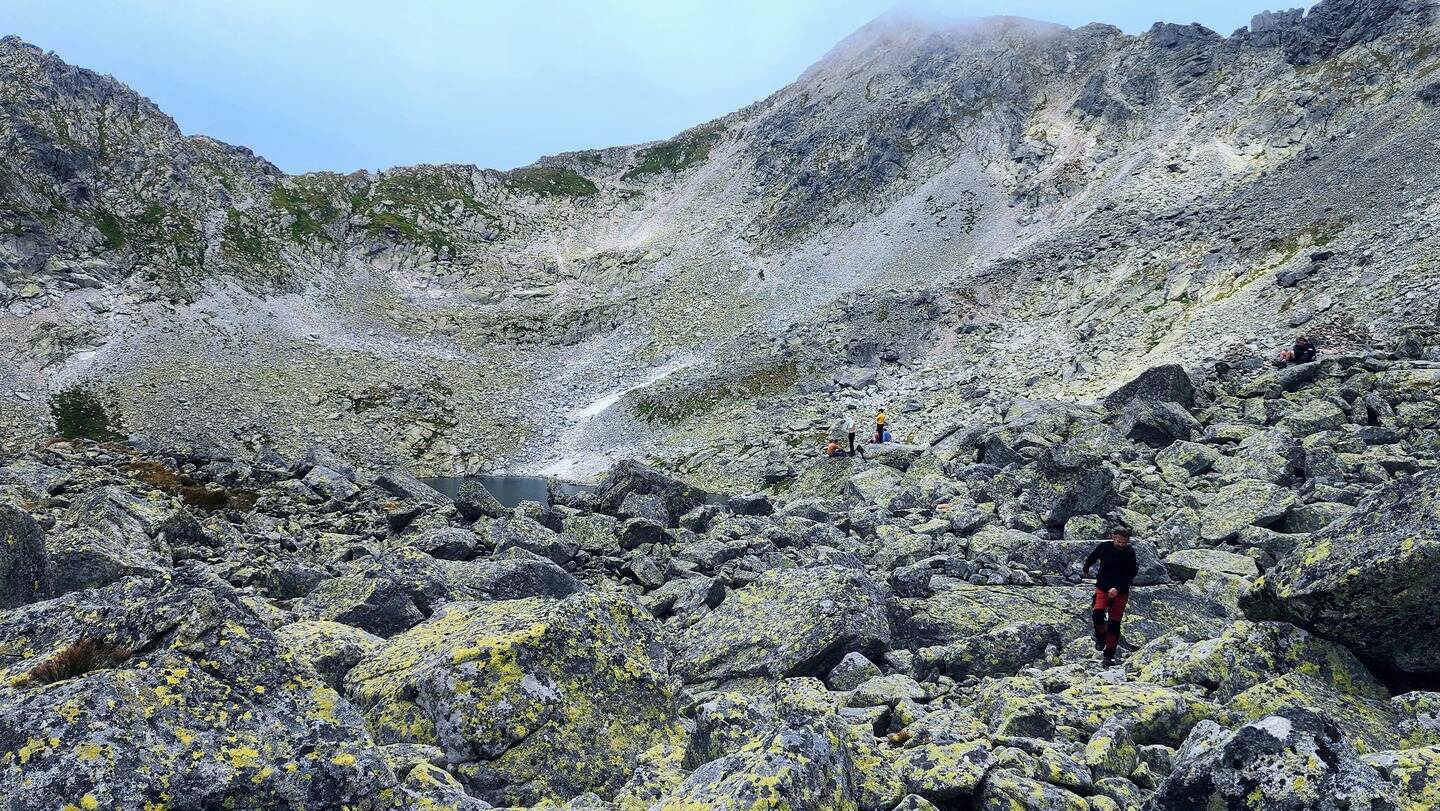
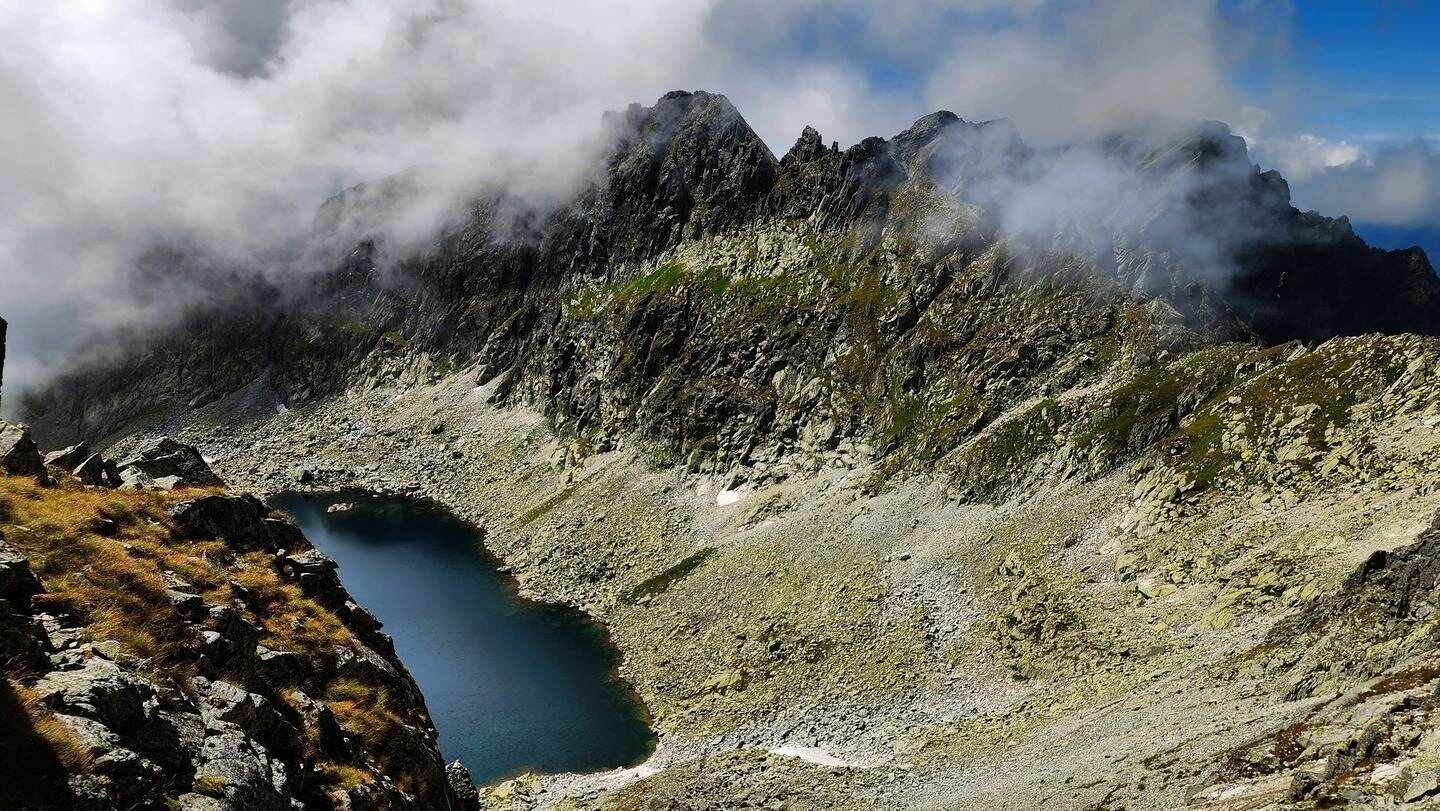
In the image, on the left, you see the descent from Bystrá Lávka, where the rugged trail winds down through rocky terrain. On the right, the image captures the breathtaking views from Bystrá Lávka, overlooking Vyšné Wahlenbergovo Pleso.
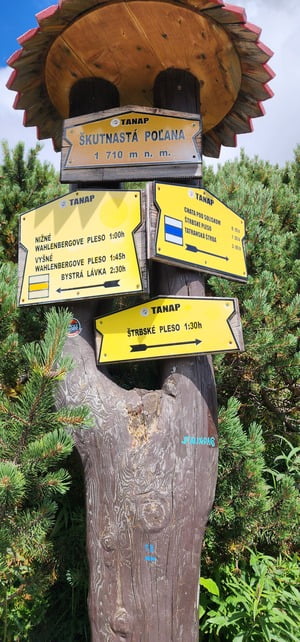
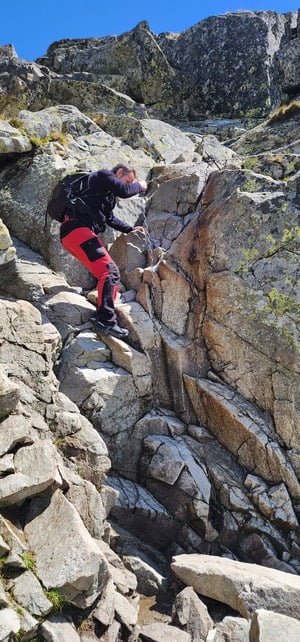
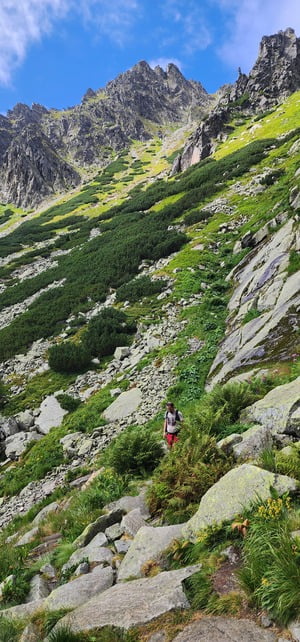
Choosing Your Path:
When descending from Bystrá Lávka, you’ll reach a crucial junction at Skutnastá Poľana. Here, you have two options:
- Chata pod Soliskom Route: You can follow the blue trail to Chata pod Soliskom, a mountain cabin where you can rest and enjoy refreshments. The trail from here is easier, leading through meadows and sparse forests. You can either hike down to Štrbské Pleso or take the chairlift for a quicker descent.
- Yellow and Red Trail: Alternatively, you can descend via the yellow trail, which eventually connects to the red trail, taking you back to Štrbské Pleso. This route offers a different scenic experience through the forested paths of the Tatras.
I reached a crossroads and decided to take the blue trail to Chata pod Soliskom. Perched at 1,840 meters, the Solisko Cabin was the perfect spot to rest my weary legs and enjoy a well-deserved break. I couldn’t resist trying some of the local offerings—a cold draft Pilsner beer and the unique Slovak drink, draft Kofola, which is a refreshing twist on cola. The cabin’s restaurant upstairs serves a variety of pre-cooked meals that are ready in minutes. I opted for the Kačka with lokše (roast duck with potato pancakes), a delicious and hearty dish that was the perfect end to my hike.
Conquer Predné Solisko: If you have the energy and time, embark on a challenging yet rewarding hike to the summit of Predné Solisko. You’ll be rewarded with breathtaking panoramic views of the Tatra Mountains.
The hike to Predné Solisko starts directly behind Solisko Cabin. The trail is well-marked and generally considered moderate, although the final ascent can be steeper. Expect the hike to take approximately 1 to 1,5 hours to reach the summit, where you’ll be rewarded with stunning panoramic views of the surrounding mountains.
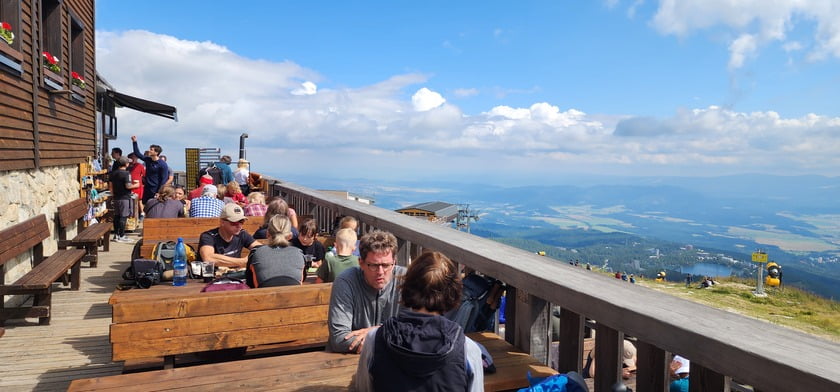
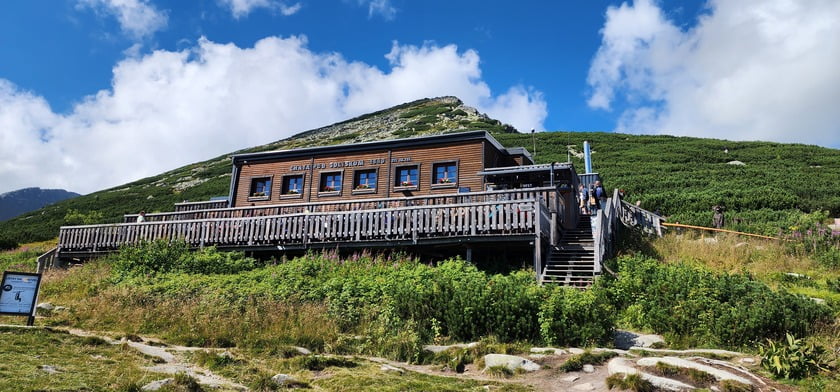
Chata pod Soliskom is a cozy mountain hut offering stunning views and a welcoming atmosphere for hikers. Nestled at the foot of the majestic Solisko Peak, the hut serves as a perfect rest stop for those exploring the surrounding trails. Behind Chata pod Soliskom, you can admire the impressive Solisko Peak rising dramatically against the sky. Whether you’re stopping for a warm meal or just to soak in the breathtaking scenery, this hut is a true gem in the heart of nature.
The final leg of the hike follows the blue trail down from Chata pod Soliskom. This part of the trail is more defined and easier to navigate, winding gently through meadows and sparse forest. After a well-deserved break at the cabin, you can either continue hiking down to Štrbské Pleso to complete the loop or opt for a quicker descent by taking the chairlift.
The Wrap-Up: Bystra Lavka is more than just a hike—it’s a journey through some of the most spectacular scenery the High Tatras have to offer. From peaceful valleys to challenging climbs, serene lakes to roaring waterfalls, this hike has it all. It’s demanding, sure, but the sense of accomplishment and the memories you’ll take away make it all worth it. So, what’s next? Lace up your boots, because the mountains are calling, and this adventure is one you won’t want to miss.
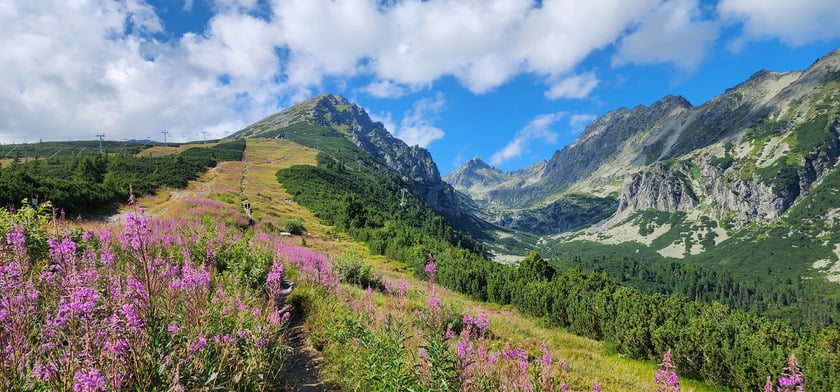
In the picture, the final leg of the hike descends from Chata pod Soliskom along the blue trail. This well-defined path winds gently through vibrant meadows and sparse forest. In the background, Solisko Peak rises majestically, creating a striking contrast against the serene surroundings, highlighting the beauty of this mountain escape.
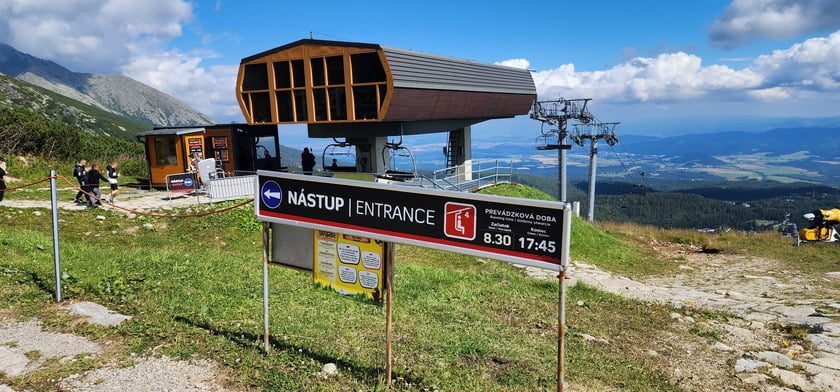

The Cherry Lift at Chata pod Soliskom typically takes about 10 minutes to reach the top. The cost of a round-trip ticket generally ranges from €10 to €15 for adults, with discounts available for children and families. Roast duck with potato pancakes and red cabbage.
Understanding the High Tatras
The High Tatras, a mountain range straddling Slovakia and Poland, offer breathtaking landscapes, diverse wildlife, and challenging hikes. To make the most of your adventure, careful planning is essential. There is no admission fee to enter Tatra National Park.
In addition to wild camping, littering, bathing in glacial lakes, building campfires, and picking flowers, Tatra National Park has several other prohibitions to protect its fragile ecosystem. Hiking off marked trails is not allowed, as it can damage the environment and disturb wildlife. Feeding animals is also prohibited, as it can harm their health and alter their natural behaviors. Motorized vehicles are banned in restricted areas to prevent damage to trails and ecosystems. Collecting natural materials, such as stones or plants, is forbidden, as is setting up permanent structures like tents or shelters. These regulations are essential for maintaining the park’s ecological integrity and ensuring that its breathtaking landscapes remain unspoiled for future generations.
The best time to visit the High Tatras for hiking is generally from late May to mid-October.
- Opening Season: Trails typically open in late May, depending on snow conditions and weather.
- Peak Season: The summer months of June to September are ideal, as the weather is usually stable and the trails are fully accessible.
- Closing Season: By mid-October, many trails begin to close due to the onset of winter weather, and snowfall can occur.
Several peaks in the High Tatras require a professional guiding service due to their technical difficulty and potential hazards. Notable examples include:
- Gerlachovský štít: The highest peak in the High Tatras, it is a challenging ascent that requires climbing skills and experience.
- Lomnický štít: While it has a cable car, the summit climb can be technically demanding and may require a guide.
- Rysy: The trail to the summit is steep and can be dangerous in certain conditions, making a guide advisable for less experienced hikers.
There are many guiding companies available, one of which is Mountain Pro Guiding. They offer a variety of guided tours and climbing experiences in the High Tatras, catering to different skill levels and preferences. Whether you’re looking to summit challenging peaks or enjoy scenic hikes, they provide professional guides to enhance your adventure.
Ensure your safety in the mountains with reliable mountain insurance.
Mountain insurance is essential when hiking or engaging in activities in the High Tatras due to the potential costs of mountain rescues, which are not covered by standard health or travel insurance. In case of accidents, individuals are responsible for paying for rescue services, such as helicopter transport or stretcher evacuation, unless covered by mountain insurance. The cost of insurance is approximately €1.50 per day.
There are two main categories of mountain insurance:
- Basic insurance: Covers hiking and movement on marked trails.
- Extreme insurance: Required for riskier activities like climbing, ski touring, or other adrenaline sports.
If you’re staying in registered accommodations within the town of High Tatras (excluding certain areas like Štrbské Pleso), you may already be insured under a collective agreement that covers search and rescue services for the duration of your stay.
For those without this collective insurance, it is advisable to purchase daily, annual, or group mountain insurance, available both online or in person at information centers in Starý Smokovec and Tatranská Lomnica.
If you’re planning to hike at altitudes over 2,000 meters or engage in multi-day treks, regular travel insurance may not suffice. Specialist mountain insurance ensures you’re covered for emergencies, equipment issues, and high-altitude risks.
You can conveniently purchase insurance from various companies online: 【install the Google Translate extension to your browser】
Emergency Numbers for the High Tatras
In case of an emergency in the High Tatras, please dial:
- Mountain Rescue:
- Slovakia: 18 300
- Poland: 601 100 300 (TOPR)
- General Emergencies (police, fire, ambulance):
- Slovakia and Poland: 112
For more information, please visit:
- Mountain Rescue Service Slovakia: Mountain rescue service Slovakia: https://hzs.sk/
- TOPR Mountain Rescue Poland: https://topr.pl/
- Official website of High Tatras National Park: http://www.tanap.org/english/
Remember to inform someone of your hiking plans before setting off, including your intended route and expected return time.
For the most accurate and up-to-date weather conditions in the High Tatras, you can visit the Meteo HZS website. This site provides real-time data, including temperature, wind speed, and other critical weather parameters for various locations in the High Tatras. It’s an excellent resource for planning your activities in the mountains, ensuring you have the latest weather information at your fingertips.
Reaching the High Tatras
By Air
Poprad-Tatry Airport (TAT): This is the closest airport to the High Tatras, just 12.5 km from the heart of the region. It’s an ideal option if you’re short on time or prefer a hassle-free journey. The airport offers flights from several European cities, including London (Luton), Warsaw, and Riga, mostly operated by Wizz Air. Upon arrival, you can easily reach popular resorts like Stary Smokovec or Štrbské Pleso via taxi, bus, or the Tatra Electric Railway (TEŽ), which connects directly from Poprad.
Bratislava Airport (BTS): Located further away, Bratislava Airport is a larger hub with more international flight options. However, getting to the High Tatras from here requires additional travel time. You can either rent a car and drive for about 3.5 hours or take a direct train to Poprad, which takes approximately 4 hours.
Krakow Airport (KRK): If you’re coming from Poland, Krakow Airport is a viable option. From Krakow, you can reach the High Tatras by renting a car, taking a bus, or traveling by train, although the journey is longer (around 3-4 hours) compared to starting from Poprad.
By Train
Poprad-Tatry Station: Poprad serves as the main gateway to the High Tatras. The station is well-connected to major cities like Bratislava, Košice, and even Prague in the Czech Republic. Trains are a comfortable and scenic option, especially if you’re traveling from within Slovakia or nearby countries. The Tatra Electric Railway (TEŽ) is a must-try; this scenic narrow-gauge train takes you from Poprad to key destinations like Stary Smokovec, Štrbské Pleso, and Tatranská Lomnica. The trains are modern, and tickets are affordable, typically costing around 2-3 EUR for a return journey depending on the distance.
By Bus
FlixBus and Local Buses: For budget-conscious travelers, buses provide an economical way to reach the High Tatras. FlixBus operates routes from various European cities to Poprad, making it an accessible option if you’re coming from places like Vienna, Budapest, or Prague. Once in Poprad, you can switch to local buses operated by Slovenská Autobusová Doprava (SAD Poprad), which run frequently between towns like Stary Smokovec, Tatranská Lomnica, and Štrbské Pleso. Look for the “TATRA EXPRESS” marking on buses for the quickest routes within the region.
By Car
Driving: Renting a car gives you the freedom to explore the High Tatras at your own pace. The roads leading to the mountains are well-maintained and offer stunning views of the Slovakian countryside. However, parking near popular trailheads and resorts can be limited, especially on weekends, so it’s best to arrive early. Parking typically costs around 10 euros, payable either in cash to an attendant or by card at a kiosk machine. Having a car is especially convenient if you plan to visit multiple towns or explore more remote hiking trails.
In general, and especially in Slovakia, it’s important to pay close attention to traffic rules and monitor your speed, as there is a significant police presence on the roads. Speed cameras are common, particularly in resort areas, where police are often stationed at either end of the village or town. Be mindful of speed limits, even in less populated areas, as radar traps can be set up unexpectedly. Also, keep an eye out for pedestrian crossings in smaller towns, as traffic rules are strictly enforced.
Unlike some other European countries, Slovakia has a strict zero-tolerance policy for alcohol when driving. Even a small amount of alcohol in your system, such as from a single beer, is prohibited. It’s important to be fully aware of this regulation to avoid serious penalties.
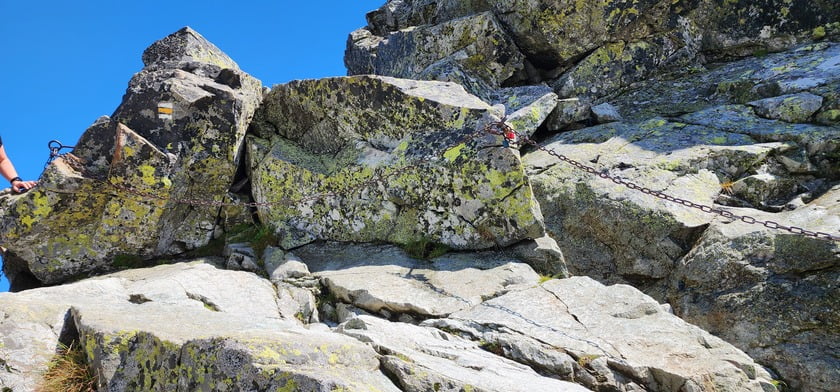
The chains provide support as you ascend or descend the rocky faces, helping you maintain your balance.
Here are some essential apps to consider for navigation and hiking in the High Tatras:
Gaia GPS or AllTrails: Both apps are highly regarded for outdoor activities, offering detailed topographic maps, trail information, and GPS tracking features. They are particularly useful for more serious hikers who need reliable data on elevation and trail conditions.
Google Maps: Widely used for general navigation, it offers detailed road maps, public transport routes, and some hiking trails.
Mapy.cz: Particularly popular in Central Europe, this app provides excellent offline maps with detailed hiking and cycling routes, including terrain features and points of interest.
Maps.me: Known for its offline capabilities, Maps.me offers a comprehensive set of trails and hiking paths, making it useful in areas with limited connectivity.
Where to Stay
For the Bystra Lavka Circuit or other hikes in the High Tatras, Autocamping Tatranská Štrba is a great base camp choice. This campsite is well-located, with easy access to numerous hiking trails, and offers reasonable rates—around €15 per night for two people, a tent, and a car. It’s ideal for those looking for a no-frills, budget-friendly stay with close proximity to nature.
For those seeking other accommodation options, Airbnb and Booking.com offer a range of alternatives:
- Airbnb: You can find charming cabins, chalets, and apartments in nearby towns like Tatranská Lomnica or Štrbské Pleso, offering more privacy and comfort than camping. Prices range from budget to mid-tier depending on location and amenities, with options for large groups or families.
- Booking.com: This platform provides a variety of accommodations, from boutique hotels to guesthouses and pensions. For instance, hotels near Štrbské Pleso are ideal for those who prefer a full-service experience, with amenities like spas, restaurants, and stunning views of the High Tatras. Prices vary but typically range from €50 to €150 per night, depending on the season and location.
- Zlavomat.sk is a popular Slovak online platform that specializes in offering discounted deals and experiences across various categories, including travel, dining, wellness, and activities. Users can find a wide range of vouchers for hotels, restaurants, spa services, and recreational activities, often at significant savings.
If you’re staying in the High Tatras for a few days, a must-visit place is the spa wellness at Hotel Grand Permon****, renowned as one of the best wellness facilities in Slovakia. You can find attractive combo deals on Zlavomat.sk, where you can book your stay at Hotel PIERIS*** with wellness services included. This offers a perfect opportunity to relax and rejuvenate while enjoying the stunning mountain surroundings.
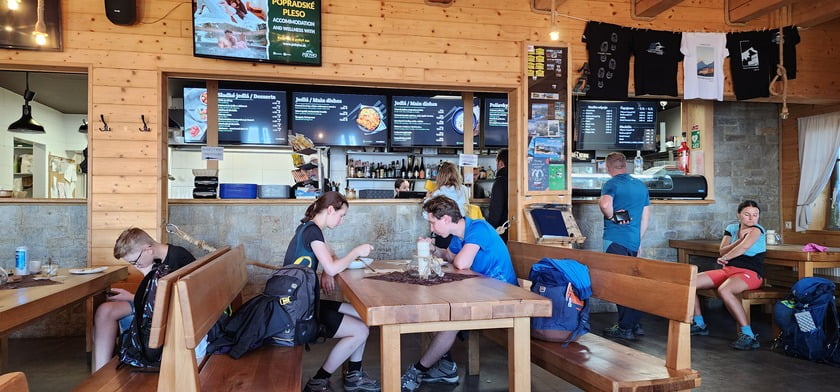
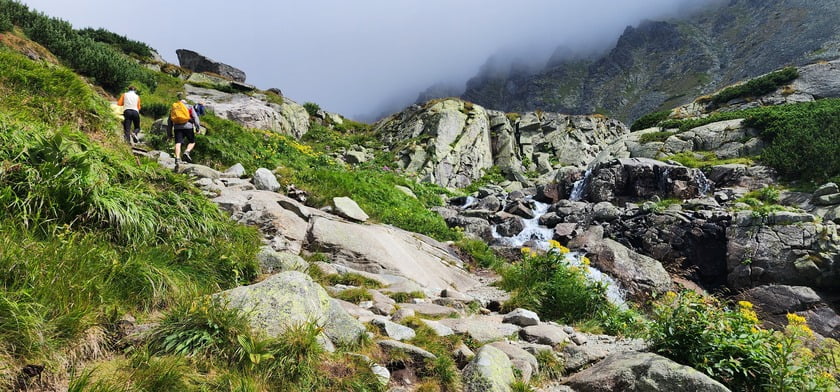
Left Image: The restaurant at Chata Solisko offers a diverse menu featuring a wide variety of meals and drinks, including numerous soups and traditional Slovak dishes. Right Image: On the right, you can see the stunning Skok Waterfall, cascading gracefully and adding to the beauty of the surrounding landscape.
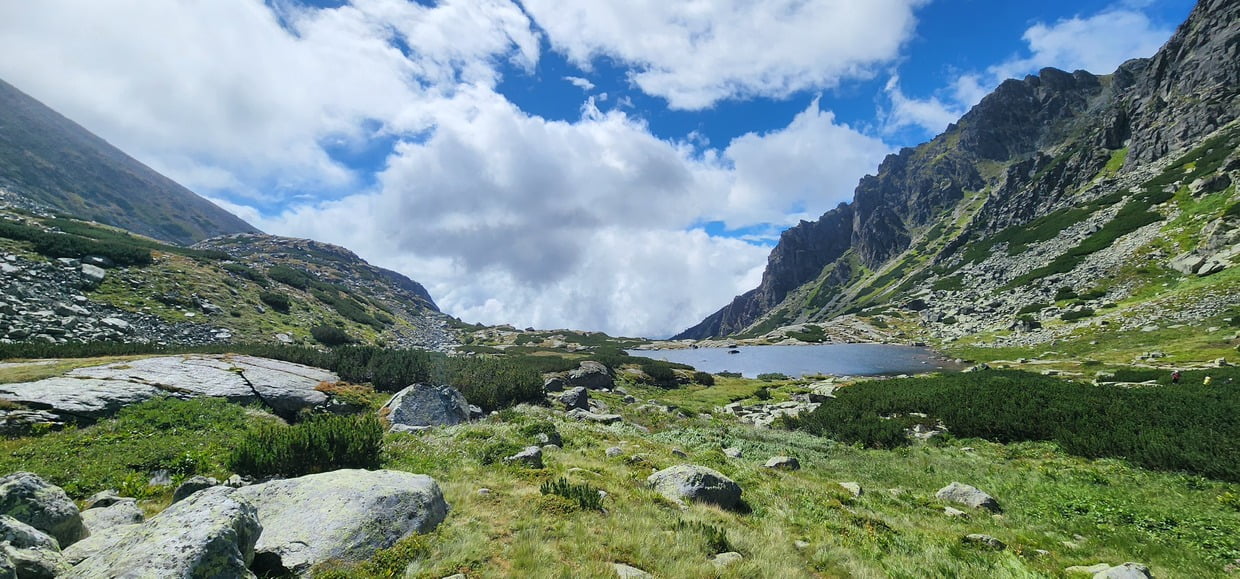
The glacial lake is a breathtaking sight, with its crystal-clear waters set against a vibrant blue sky. Wisps of clouds drift lazily above, while majestic peaks rise around it, creating a dramatic and serene landscape that invites you to soak in the beauty of nature.
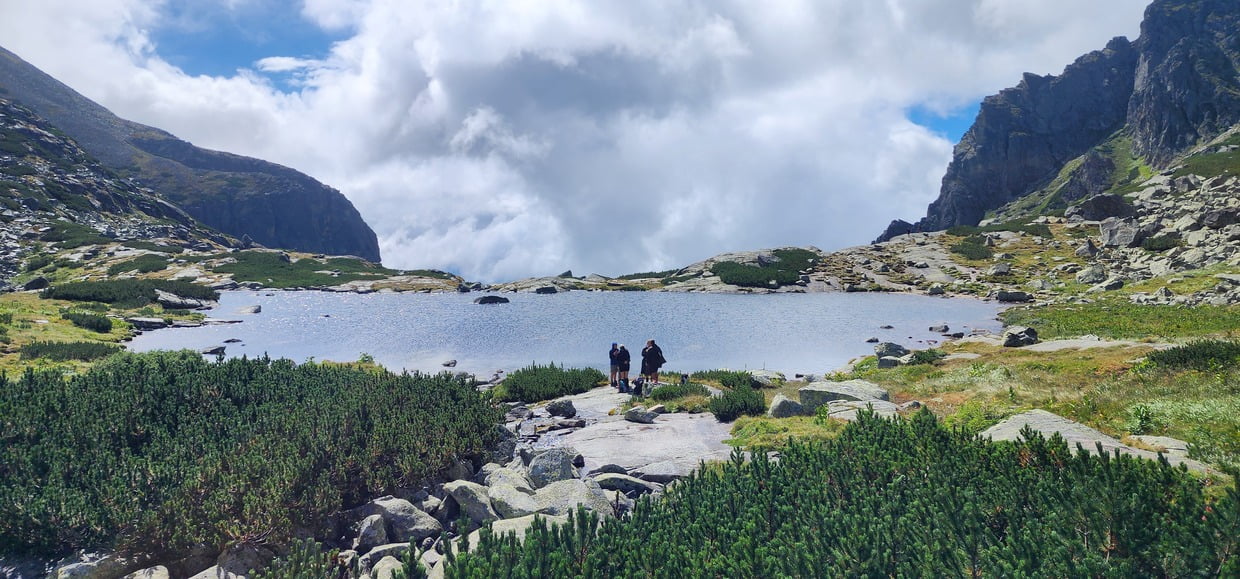
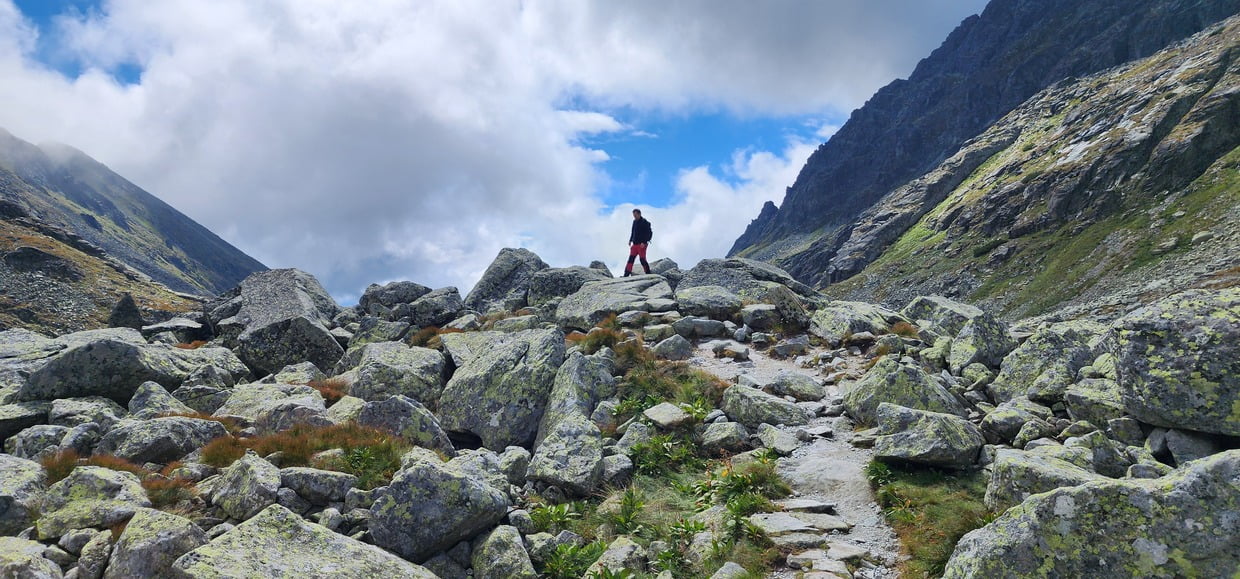
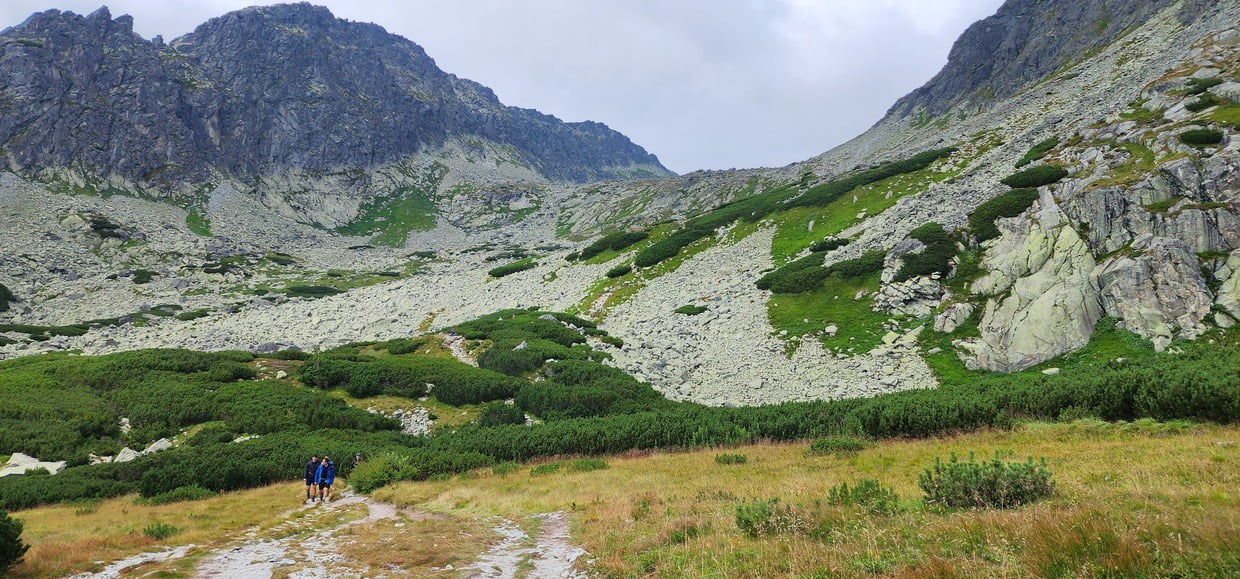
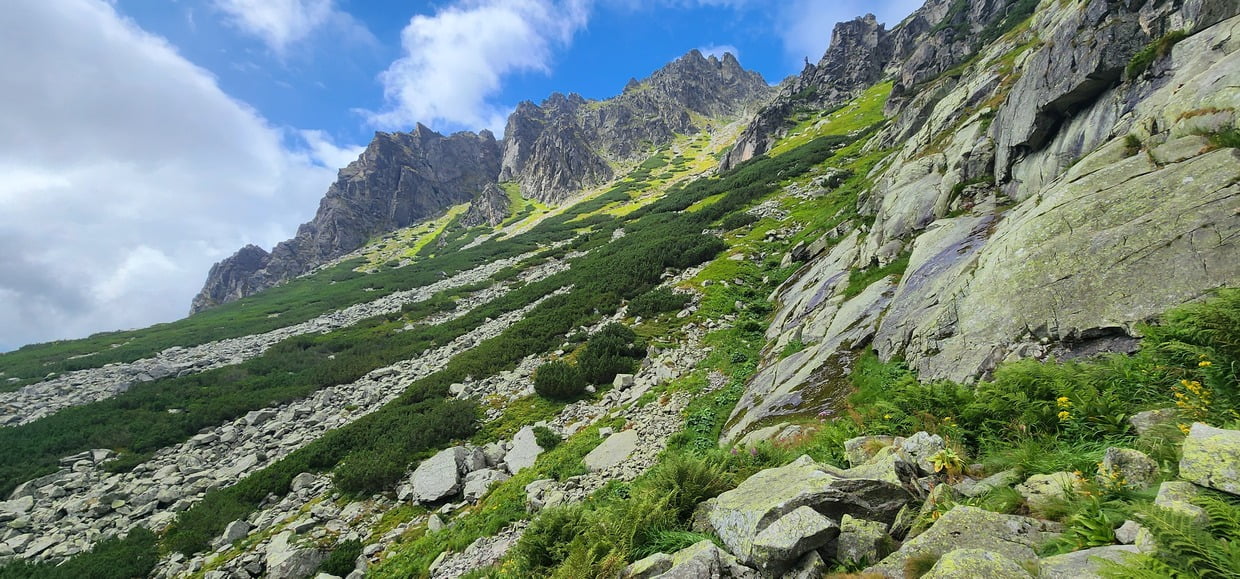
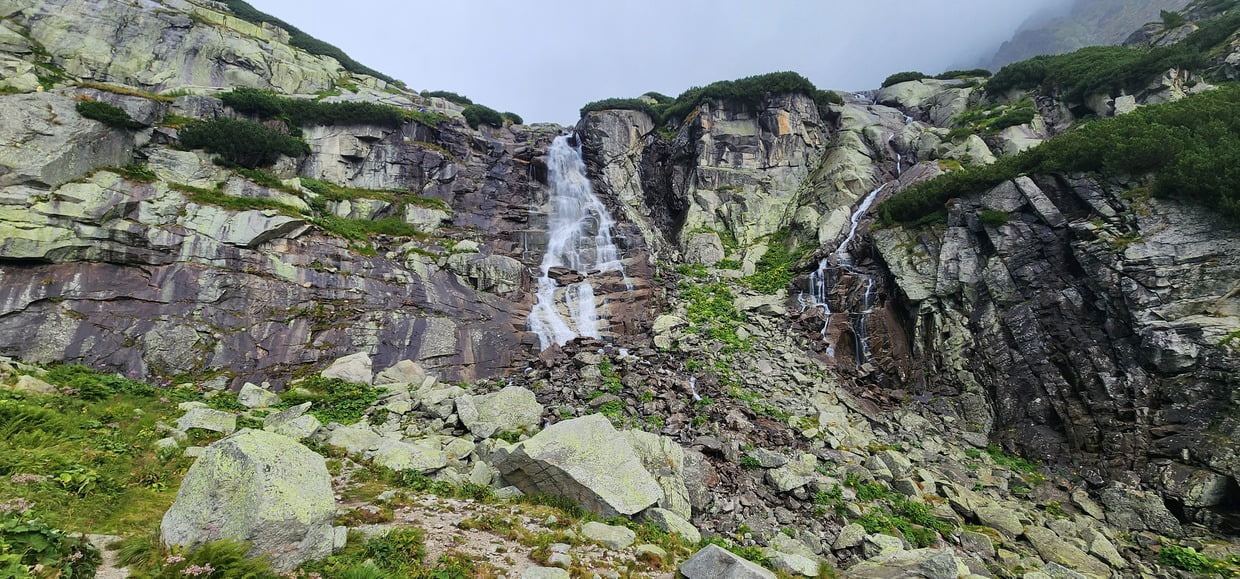
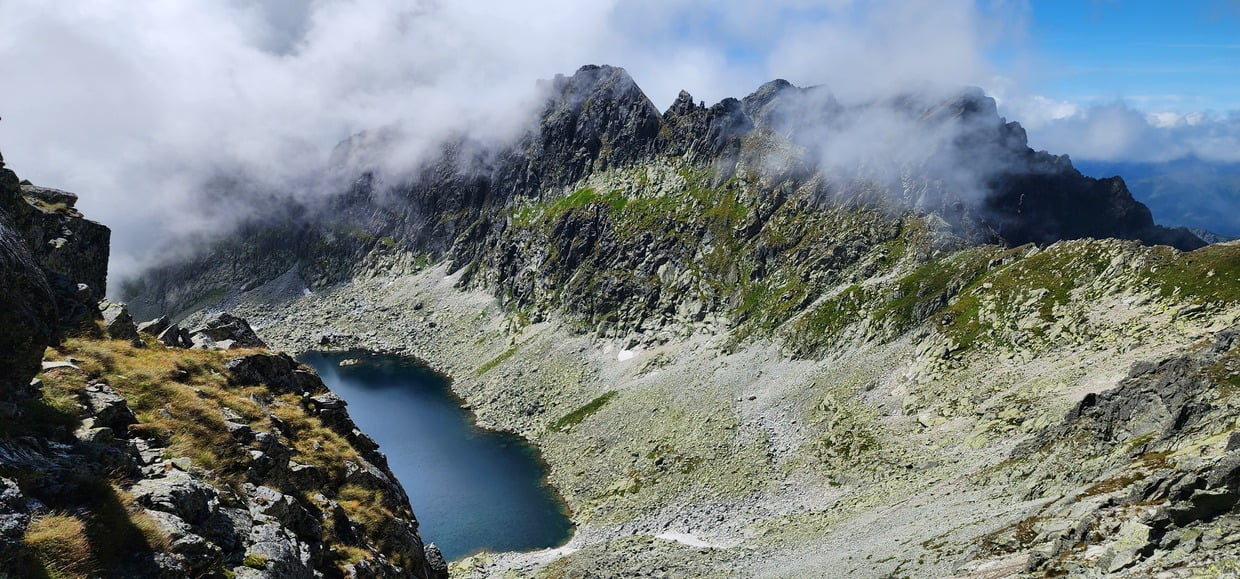
Bystrá Lávka is a stunning mountain pass that offers breathtaking views of Vyšné Wahlenbergovo Pleso, a picturesque glacial lake nestled amidst the rugged terrain of the High Tatras.
